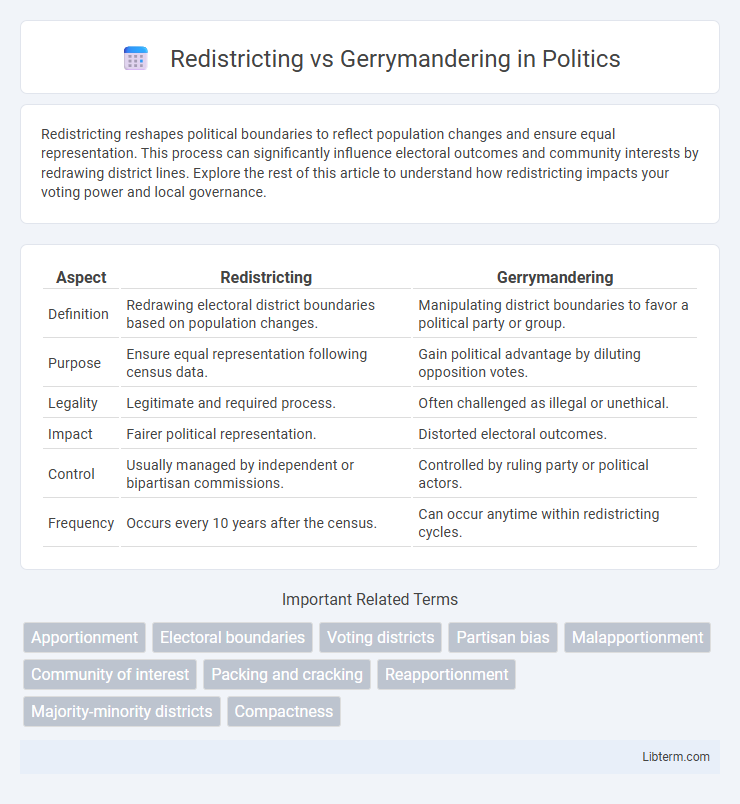Redistricting reshapes political boundaries to reflect population changes and ensure equal representation. This process can significantly influence electoral outcomes and community interests by redrawing district lines. Explore the rest of this article to understand how redistricting impacts your voting power and local governance.
Table of Comparison
| Aspect | Redistricting | Gerrymandering |
|---|---|---|
| Definition | Redrawing electoral district boundaries based on population changes. | Manipulating district boundaries to favor a political party or group. |
| Purpose | Ensure equal representation following census data. | Gain political advantage by diluting opposition votes. |
| Legality | Legitimate and required process. | Often challenged as illegal or unethical. |
| Impact | Fairer political representation. | Distorted electoral outcomes. |
| Control | Usually managed by independent or bipartisan commissions. | Controlled by ruling party or political actors. |
| Frequency | Occurs every 10 years after the census. | Can occur anytime within redistricting cycles. |
Understanding Redistricting: Definition and Purpose
Redistricting involves redrawing electoral district boundaries to reflect population changes and ensure equal representation, typically conducted every ten years following the census. Its primary purpose is to maintain balanced voter distribution, so each district has roughly the same number of constituents, preserving the principle of "one person, one vote." Unlike gerrymandering, which manipulates boundaries to favor a political party or group, redistricting aims to create fair and competitive districts based on demographic data and legal criteria.
Gerrymandering Explained: Manipulating Electoral Boundaries
Gerrymandering involves the deliberate manipulation of electoral district boundaries to favor a specific political party or group, often resulting in distorted representation. By strategically drawing lines to concentrate or dilute voting power, gerrymandering skews election outcomes and undermines democratic fairness. This practice contrasts with legitimate redistricting, which aims to create balanced districts based on population changes.
Key Differences Between Redistricting and Gerrymandering
Redistricting involves the systematic redrawing of electoral district boundaries based on population changes to ensure fair representation, while gerrymandering manipulates these boundaries to favor a particular political party or group. The key difference lies in intent: redistricting aims for equal population distribution and compliance with legal standards, whereas gerrymandering seeks to maximize electoral advantage by creating districts with skewed demographics. Methods such as "packing" and "cracking" define gerrymandering's tactics, contrasting with redistricting's emphasis on impartiality and demographic fairness.
Historical Context: Redistricting and Gerrymandering in the U.S.
Redistricting in the U.S. is the decennial process of redrawing electoral district boundaries to reflect population changes reported by the Census, ensuring equitable representation. Gerrymandering, a term originating from an 1812 Massachusetts redistricting under Governor Elbridge Gerry, manipulates district lines seeking partisan or racial advantage. Historical cases like the 1960s Supreme Court rulings in Baker v. Carr and Reynolds v. Sims established "one person, one vote," challenging gerrymandering practices and shaping modern redistricting laws.
Legal Framework Governing Redistricting
The legal framework governing redistricting is primarily shaped by the U.S. Constitution, the Voting Rights Act of 1965, and numerous Supreme Court rulings that set standards for equal population and non-discriminatory districting. Redistricting must comply with the Equal Protection Clause of the Fourteenth Amendment, requiring districts to have roughly equal populations to uphold the principle of "one person, one vote." Gerrymandering, by contrast, involves manipulating district boundaries for political advantage, often resulting in legal challenges when such practices dilute voting power or violate civil rights protections.
Common Tactics Used in Gerrymandering
Gerrymandering involves manipulating electoral district boundaries to favor a particular political party, often through tactics like "cracking" and "packing." Cracking dilutes opposing voters across multiple districts, preventing them from achieving a majority, while packing concentrates opposition voters into a single district to minimize their influence elsewhere. These strategies undermine fair representation and distort electoral outcomes compared to neutral redistricting practices aimed at equal population distribution and compliance with legal standards.
Impact of Redistricting and Gerrymandering on Voter Representation
Redistricting aims to redraw electoral boundaries to reflect population changes and ensure equitable voter representation, but gerrymandering manipulates these boundaries to favor specific political parties or groups, undermining democratic principles. Gerrymandering distorts electoral outcomes by concentrating or diluting voter groups, leading to disproportionate representation and diminished electoral competitiveness. Consequently, voter voices can be marginalized, skewing political power and weakening the legitimacy of representative democracy.
Notable Cases of Gerrymandering in Recent History
Notable cases of gerrymandering in recent history include the 2010 Pennsylvania congressional map, which was struck down by the state Supreme Court for favoring Republicans, resulting in a more balanced representation. In North Carolina, multiple court rulings between 2018 and 2022 identified racial gerrymandering, prompting court-ordered redistricting to ensure fairer elections. Wisconsin's 2011 redistricting plan was also challenged and ultimately modified after courts found it intentionally diluted Democratic votes, highlighting ongoing legal battles over partisan map drawing.
Reform Efforts: Combating Gerrymandering
Reform efforts targeting gerrymandering emphasize the implementation of independent redistricting commissions to ensure fairer electoral boundaries free from partisan influence. Several states, including California and Arizona, have successfully adopted such commissions, resulting in more competitive districts and increased voter representation. Legal challenges and technological advancements in mapping tools also play critical roles in identifying and preventing manipulative district designs.
The Future of Fair Redistricting
Fair redistricting requires the use of independent commissions and transparent algorithms to prevent gerrymandering, which manipulates electoral boundaries for political advantage. Advanced data analytics and public participation are transforming the redistricting process, ensuring districts reflect genuine community interests and demographic realities. Legal reforms and technology-driven oversight promise more equitable representation and stronger democracy in future electoral maps.
Redistricting Infographic

 libterm.com
libterm.com